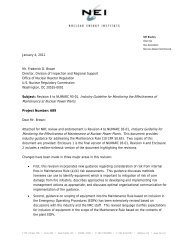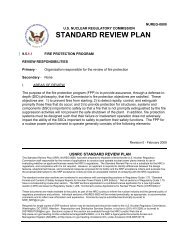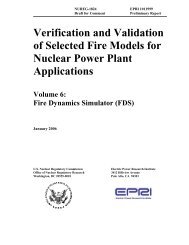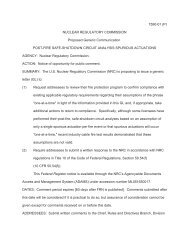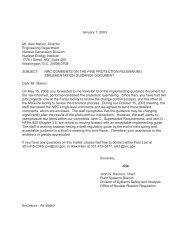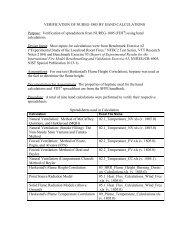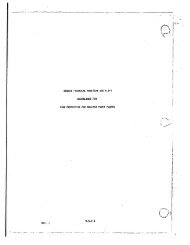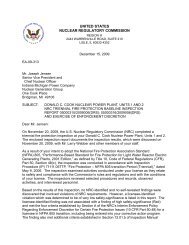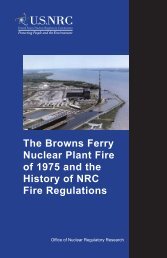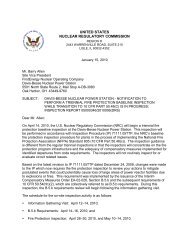NUREG/CR-6850, Volume 1 - NRC
NUREG/CR-6850, Volume 1 - NRC
NUREG/CR-6850, Volume 1 - NRC
Create successful ePaper yourself
Turn your PDF publications into a flip-book with our unique Google optimized e-Paper software.
Conclusions and Closing RemarksFuture Fire PRA applications may introduce unique needs that would not be met given thescreening approaches applied in most past analyses. Future applications will involve morecomplex objectives, and will likely seek to retain potential risk contributors at a much moredetailed level. For example, NFPA 805 [3.1] uses Fire PRA in the evaluation of plant changes.Plant changes may impact previously screened fire scenarios or fire analysis compartments.Hence, the new method recommends that information on screened fire scenarios andcompartments be retained in the PRA process documentation. Retaining such information willallow a user to revisit the original screening basis, and to assess the impact of a plant change onthe screening decision.3.2.3 General Treatment of Fire Event Data and Fire Frequency AnalysisConsistent with common practice, fire event frequencies are estimated based on the analysis ofpast fire experience [3.2]. The analysis documented here follows common and accepted practicewith regard to issues such as fire ignition source binning, fire location binning, and treatment offire events reported during non-power operational modes. One area of advance in fire frequencyestimation is an increased use of the plant-wide fire ignition source approach and an expandedlist of plant-wide fire ignition sources (more ignition source bins).Under the recommended approach, the fire frequency estimates are tied to component level fireignition frequencies. For example, the plant-wide fire frequency for electrical control panels isspecified, and this fire frequency is partitioned to individual electrical control panels based onthe total count of such panels in the plant. For example, to estimate panel fire frequency for a fireanalysis compartment, the total plant wide frequency is multiplied by the number of panels in thecompartment and divided by the total number of panels in the plant.3.2.4 Fire Severity TreatmentThe issue of fire severity has been an important area of ongoing technical debate. Past practicehas often utilized severity factors to characterize the fraction of all fires that were actuallyrisk-important. The recommended practice documented in this report represents a largely newapproach that specifically minimizes the potential for double-counting errors.Fire severity is accounted for through a two-step process. The first step involves analyzing fireevent data and the generation of fire event frequencies. The second step involves the inputassumptions used in fire modeling.In the first step, reported fire events are screened for inclusion in, or exclusion from, the fireevent frequency using a specific set of objective and subjective criteria. Fire events are includedonly if they actually did, or under other circumstances may have, represent(ed) a potential threatto plant safety (e.g., fire spread to secondary combustibles and/or damage to one or more targetsother than the fire ignition source itself). Given this approach, the fire event frequency estimatesalready include some aspects of the overall concept of fire severity that, in past practice, wouldhave been captured under the general fire severity factor.3-4





